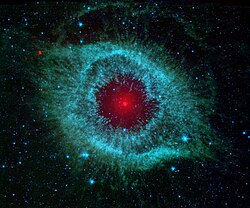Eye of God
| Nebula | |
|---|---|

Helix Nebula taken by the Spitzer Space Telescope (Infrared, 2007)
Credit: NASA, JPL, Caltech, Kate Su (Steward Obs., U. Arizona). |
|
| Observation data: J2000 epoch | |
| Right ascension | 22h 29m 38.55s |
| Declination | −20° 50′ 13.6″ |
| Distance |
714+88 −68 ly (219+27 −21 pc) ly |
| Apparent magnitude (V) | +7.6 |
| Apparent dimensions (V) | 25′ |
| Constellation | Aquarius |
| Physical characteristics | |
| Radius | 2.87 ly (0.88 pc) ly |
| Notable features | One of nearest PNs |
| Designations | NGC 7293Caldwell 63 |
The Helix Nebula, also known as The Helix, NGC 7293, is a large planetary nebula (PN) located in the constellation Aquarius. Discovered by Karl Ludwig Harding, probably before 1824, this object is one of the closest to the Earth of all the bright planetary nebulae. The estimated distance is about 215 parsecs (700 light-years). It is similar in appearance to the Cat's Eye Nebula and the Ring Nebula, whose size, age, and physical characteristics are similar to the Dumbbell Nebula, varying only in its relative proximity and the appearance from the equatorial viewing angle. The Helix Nebula has sometimes been referred to as the "Eye of God" in pop culture, as well as the "Eye of Sauron".
The Helix Nebula is an example of a planetary nebula, formed by an intermediate to low-mass star, which sheds its outer layers near the end of its evolution. Gases from the star in the surrounding space appear, from our vantage point, as if we are looking down a helix structure. The remnant central stellar core, known as a planetary nebula nucleus or PNN, is destined to become a white dwarf star. The observed glow of the central star is so energetic that it causes the previously expelled gases to brightly fluoresce.
The Helix Nebula in the constellation of Aquarius lies about 700 light-years away, spanning about 0.8 parsecs (2.5 light-years). Recent images by the Hubble Space Telescope of the Helix Nebula are a composite of newly released images from the ACS instrument and the wide-angle images from the Mosaic Camera on the WIYN 0.9-metre telescope at Kitt Peak National Observatory.
...
Wikipedia
